
22 minute read
Technical


Evergreens (UK) to use revolutionary air purification technology in artificial grass
In a global marketplace forecast to be worth £4.2b by 2023*, Accredited Supplier Evergreens (UK) has written to Landscape News to announce, what it calls, a revolutionary air purification Artificial Grass range - introducing AIR™.
Mature trees play a vital role in tackling the issue of airborne pollution, their foliage providing absorption and purification. Speaking to Evergreens (UK), they have developed a new solution: AIR™ from ArtificialGrass.com, which launches this spring. With every square metre replicating the air purifying skills of a mature tree, an average size AIR™ treated lawn can pack the same pollution-busting punches as 50 mature trees. One average lawn can contend with over 1kg of nitrogen oxide per year, neutralising the equivalent of a car engine’s emissions running 20km a day for a whole year.
How does it work?
Activated by sunlight, AIR™ artificial grass, pre-treated in its production process with AIR™ technology powered by Pureti, helps remove nitrogen oxides and dioxides from harmful car emissions and industrial output. Its eco-friendly, air-purifying, self-cleaning solution combats methane build-up from animal excretions and household emissions such as formaldehyde, present in cleaning products, cosmetics and pesticides.
AIR™ technology
When UV or direct sunlight strikes the treated surface, it activates selfcleaning photocatalytic TiO particles. 2 The artificial grass then uses this energy to transform humidity into powerful oxidizing agents that destroy harmful organic compounds and pollutants in the air, naturally returning them to harmless water vapour. This process repeats millions of times per second, destroying pollutants and allowing cleaner air to continuously circulate across the treated surface.
On hearing this news, our Technical Officer, Owen Baker, investigated titanium dioxide, reporting, “Titanium is a metal commonly found in plants and animals. Similarly, titanium dioxide is a naturally occurring mineral which has many useful properties. In the 1960s researchers discovered that, under intense UV light, a variant of titanium dioxide has the potential to decompose inorganic materials into carbon dioxide. A development of this research resulted in titanium dioxide being used in catalyst devices on cars to remove pollutants from engine exhaust gas emissions, as well as on exhaust gases of power stations. In recent years research has focussed on the potential of titanium dioxide to be used more widely on surfaces, where – under UV light – it has the potential to serve as a coating on urban buildings to decompose pollutants and allow the surface of the building to self-clean. By 2000 research started investigating the potential of titanium dioxide to be used as a means of purifying air in urban areas by coating concrete paving blocks with it, with the intention of reduce the concentration of nitrogen dioxide – a harmful airborne pollutant – from the environment to benefit human health. Controlled conditions in laboratory tests gave positive results and proved the technology has the potential to contribute to a reduction in airborne pollutants, however, implementation of the technology in urban areas resulted in several variables, including exposure to abrasion, contaminants on the surface and a lack of consistent UV light. Research proves the potential of the technology in the fight against pollution, but the variability of real-life applications has limited adoption so far and here at the British Association of Landscape Industries we are looking forward to seeing how this particular product is developed.” For more information visit
artificialgrass.com/air.
You can also contact the team on +44(0)800 246 5566.

*UpMarketResearch Report: Published November 2019 - Artificial Grass Turf Market Size, Share, Trends, Growth, Forecast Analysis Report by Product, By Application, By Segment, By Region - Global Forecast 2018-2023 .
Report by Owen Baker
Technical Officer (Policy & Research)
Fuel for thought

The race to reduce greenhouse gas emissions is on. Fuelled by a commitment made by the UK government and devolved administrations to reach a target of net-zero by 2050, big changes are afoot to reduce emissions generated by human activity. Whilst the definition of ‘net-zero’ allows some wiggle-room in terms of off-setting emissions, the task remains a significant one.
To meet the target, the biggest emitters of greenhouse gases will be expected to implement emissionreducing initiatives. As the largest emitter of greenhouse gases in 2019, the transport industry - or at least a part of it - is first to face changes, with proposals to transition to a greener petrol from September 2021.
There is potential to change the composition of petrol to produce (slightly) fewer greenhouse gases during combustion in engines of all sizes. Whilst this new variant of petrol is (slightly) better for the environment and unlikely to affect the majority of car owners, operators of 2-stroke and 4-stroke petrolpowered landscape equipment are encouraged to pay attention to what fuel they are using from September 2021 to avoid negative consequences from the change.
Most readers will have heard of the term ‘biofuel’, which is broadly defined as fuel produced from plant or animal matter, as opposed to the traditional geological processes involved in fossil fuel production. Ethanol is a type of biofuel that can be produced via a process of fermentation from any raw material which contains a high proportion of sugar or starch, commonly sugar cane, sugar beet and molasses. Fossil fuels may be combined with ethanol.
Most standard unleaded petrol currently sold in the UK contains 5% ethanol and features an ‘E5’ label on the pump. From summer 2021 the proportion of bioethanol will increase to 10% and be labelled ‘E10’.
Whilst increased ethanol use is of potential benefit to the environment, it poses challenges to owners of smaller petrol-powered equipment and members should be aware of the following potential issues: • Ethanol can cause problems in older machinery by dissolving soft materials used in parts such as seals and gaskets, not designed to be immersed in petrol which contains ethanol
• Prolonged exposure to ethanol can result in parts failing, resulting in fuel
leaks or poorly running engines • When in long term storage (for example, during the winter), fuel containing ethanol may also become acidic and cause corrosion of aluminium, zinc and galvanised materials, brass, copper and lead/tin coated steels – all of which are likely to be found in older engines
Due to its propensity to absorb – and later separate – from water, ethanol can cause water to settle within parts of the engine such as the fuel tank, carburettor, or fuel injection system and cause difficult starting and even corrosion. Consequently, landscape equipment stored for a period of more than 30 days may be difficult to start and require stale fuel draining from the fuel system prior to use. Engines fitted to landscape equipment sold within the past 10 years are generally compatible with petrol containing ethanol, to the extent that the materials used in their manufacture are resistant to the potentially corrosive effects of ethanol. Although guidance differs between manufacturers (and the instruction manual should be the first point of reference), most equipment sold within the last 10 years can be run on either E5 or E10 petrol without any modification.
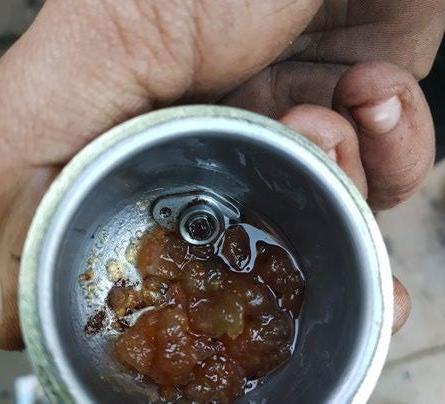

Owners of older equipment, or those who wish to avoid running their equipment on fuel with 10% ethanol, have options: • Several manufacturers offer fuel specifically formulated for new and old landscape equipment which contains no ethanol. For example, Accredited Supplier
Andreas Stihl produce Moto4Plus for 4-stroke engines and MotoMix for 2-stroke engines. • Aspen is another brand who offer ethanol free fuels and pre-mixed 2-stroke fuel for landscape equipment
From September 2021, all premium or super-unleaded fuel will be sold with a lower 5% ethanol content for the foreseeable future. This fuel is more expensive than standard unleaded but ensures greater compatibility with older engines.
Regardless of equipment age, however, is the need to ensure the correct procedure is followed prior to storage of machinery for more than 30 days, to prevent equipment damage and breakdown.
Guidance differs between manufacturers, with some suggesting all fuel is drained from machines prior to storage, whereas others suggest an additive - commonly called fuel stabilisers - may be added to the fuel tank prior to machine storage to prevent petrol from deteriorating.
Owner’s manuals should be the consult if in doubt. The ethanol-free fuels discussed earlier can remain in machines without issue and generally have a storage life of several years. The change to E10 fuel is a quick fix whilst longer-term sources of power, which produce fewer greenhouse gases, are developed. Despite advances in battery technology, gaps remain in product capability and user needs, which means petrol and diesel engines will remain for the foreseeable future.
Modern machinery is faster, more powerful and efficient than ever before, and the industry has come to expect relentless progress from manufacturers of all types of equipment. However, machinery must use sophisticated technology to meet increasingly stringent regulations, which makes it sensitive to poor maintenance. Operators play an increasingly important role in ensuring of equipment is running at optimum efficiency.

Owen Baker - Technical Officer (Policy & Research)
Visit website
CLAIM FREE 18V BATTERIES & BLOWERS.



WITH SELECTED 18V & TWIN 18V GARDEN PRODUCTS

Free 1x BL1850B 18V LXT 5.0Ah Battery or 1x DUB185Z 18V LXT Blower (Body Only) eligible for redemption with selected RT, RTE, RTX and RT8 suffix machines. Free 2x BL1850B 18V LXT 5.0Ah Batteries or 1x DUB184Z 18V LXT Blower (Body Only) or 1x DUB362Z Twin 18V LXT Blower (Body Only) eligible for redemption with selected PT2, PT4, PG2 and CT2 suffix machines. Promotion runs from 1st February to 31st May 2021. Claims must be made within 28-days of purchase. Terms & Conditions apply. See website for details. makitauk.com/redemption




Report by Owen Baker
Technical Officer (Policy & Research)
Custodians of the landscape, hear our call, we have a planet to save

By our very nature, landscape professionals care for the environment. We are more than designers, constructors or suppliers; we are custodians of the land who take pride in leaving landscapes in a better condition than before we found them.
Long before climate change and sustainability were headline news, landscape professionals were making positive contributions to the environment at every scale, creating habitats for flora and fauna, managing water responsibly and increasing the cover of plants.
As time has progressed and data gathered, scientific evidence suggests, unless global greenhouse gases are reined-in by 2050, it will be impossible to prevent a global average temperature increase, which will bring potentially disastrous levels of flooding, drought, and famine on a global scale.
In response, the UK committed to the 2008 Climate Change Act and with it, an 80% reduction in carbon emissions relative to 1990 levels, to be achieved by 2050. In 2019 the target was increased to a reduction of at least 100%.

Whilst measures to reduce emissions have largely gone unnoticed until now, meeting the 2050 target will mean national government policies aimed at reducing carbon emissions are likely to get a lot more personal.
As already mentioned in this edition of Landscape News, transport - the biggest producer of greenhouse gases in 2019 - is now being targeted. Due to its reliance on fossil fuels for equipment and transportation, the landscape industry is facing potentially costly initiatives to encourage adoption of equipment that consumes renewable energy sources as opposed to fossil fuels.
However, outside of government mandated policies, the landscape industry continues to strive for excellence, by delivering voluntary initiatives that show care for the environment and resources.
Accredited Supplier Barcham Trees have recently developed a system to help customers identify the extent to which different tree varieties lock-up carbon during growth. Using a home appliance style ‘A’ to ‘E’ rating, the measurement is estimated dry weight at maturity, so the longer a tree lives and the larger it gets, the better a contribution it can potentially deliver.
Here at Landscape House, our team is in the process of arranging an online presentation for members, from an American business, who are pioneering a system of measuring the whole life carbon cost of a landscape project. It’s incredibly exciting prospect so make sure you bookmark our website, bali.org.uk and ensure you are signed up to receive our weekly BALI Newsletter by contacting my colleague Darren Taylor, darren.taylor@bali.org.uk to be one of the first to hear the news and confirm your place.
Visit website

Wild about landscapes
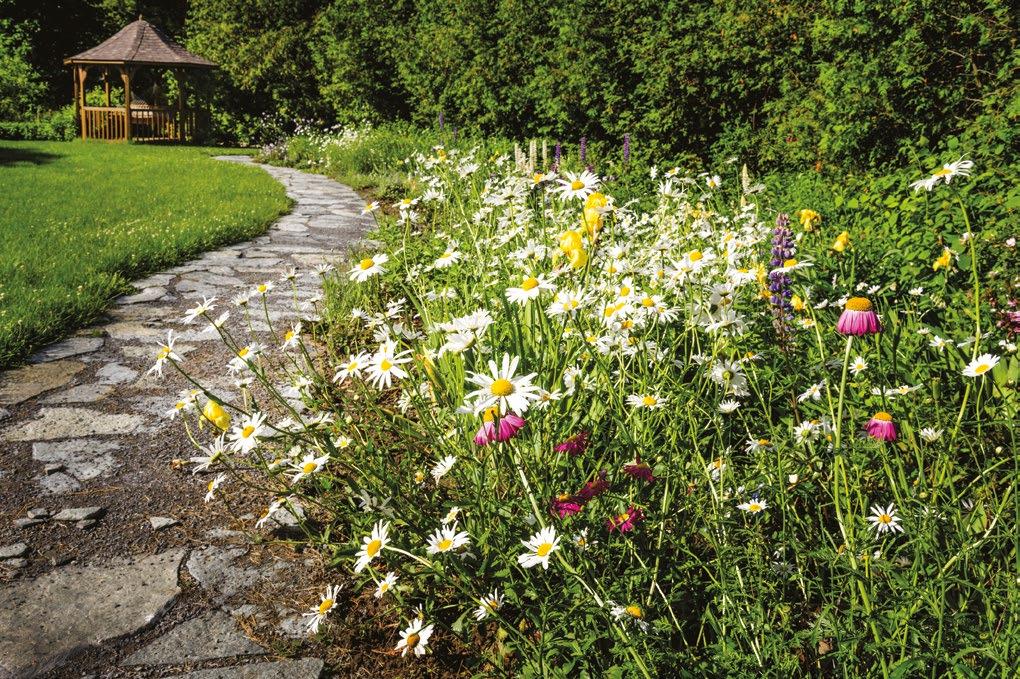
British native wildflower seed and bulbs, grass seed, wildflower matting, insect and wildlife habitats.


• Over 80 British native mixes • Mixes to attract specific insects and for specific soils • Improves the landscape and provides impact • Versatile and low maintenance • Adds biodiversity
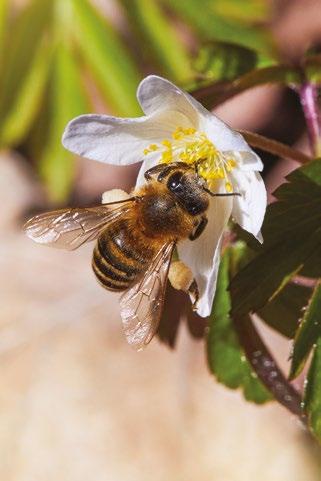
Free CPDs available –call or book online
Request or download our brochure today
Wildflower Seed and Matting
Wildflower Bulbs Grass Seed Habitats
T: 01423 332 115 E: info@johnchamberswildflowers.co.uk www.johnchamberswildflowers.co.uk
In Canberra you must have a licence for residential building work, including structural landscaping
Raising standards in landscaping

In the last edition, I mused on the perceived value of landscaping and suggested ways in which members could focus on those clients that value what you do, rather than trying to change the minds of those that don’t. This time we explore how raising standards could increase the perceived value of our industry.
Looking back 20 years, there were aspirations for our Trade Association to be like “Corgi” (now “GasSafe”), a body so strong that using anyone but an accredited contractor would render insurances null and void, invalidate material warranties etc. Big claims indeed and an initiative that lost some traction as those involved retired from the board. It’s probably fair to say that it was just too big a dream at that point, but I recently came across evidence that suggests it might be time to re-open the case?
I was shadowing a new vetting officer last year on a visit to see Paul Bentley of Accredited Contractor The Landscape Gardener Southern. Paul had not long returned from a stint in Australia and was curious that trades didn’t require any licensing to operate in the UK.
Whilst writing this, my thoughts drifted back to my conversation with Paul. After all, if a sector is licensed it raises the barriers to entry and it will naturally become more valuable… wont it? Having so few barriers to entering the landscape market is, in my opinion, why rogue traders persist. Anyone with a trowel and a wheelbarrow can do a leaflet drop and is up and running. But what if they needed a license to trade, how would that affect the marketplace?
I have taken a brief look at systems in Australia and the US to see what’s involved, and if it could work in the UK.
In New South Wales (NSW), a state that includes the capital (Canberra) and Sydney, you must have a licence before you do any residential building work, including “structural landscaping” valued at more than A$5000 (approx. £2,700). There are different levels of licence, and costs range from around $200 to around $325 per year. This is in addition to the NSW Fair trade license. Queensland is similar, with a lower threshold of A$3,300. In South Australia, you need a builder’s licence and a supervisor’s license to carry out any landscape works.
Things are a little more relaxed in the Northern Territory, where trading requirements vary from council to council, with some requiring you to hold a home improvement licence. Like Australia, there are too many to list here, but there are a range of controls in use across the states. Most require a licence similar to our PA system for applying chemical pesticides. Some consider landscaping a specialty and require licenses for all landscape works. Some states just require a license for structural work, a little like Australia.
In addition to licencing, some states also require a surety bond of which varies in value but $10,000 seems typical. Some have no specific licensing but advise you to check your local licencing requirements.
When it comes to eligibility to hold such licences, these vary from state to state too. Most states with special licencing in place require experience, normally 3-4 years. Most also require a qualification at Level 3 or above, as well as a test or exam at the time of applying for the license. It appears to be reasonably common to require some form of trading license to run any business too, and these often require the passing of an exam, to ensure operators have an understanding of the laws governing their business.

Report by Richard Gardiner
Technical Officer (Quality Assurance)
Now I’m not one for too much red tape, much of it serves little purpose in my view, but I do feel that if the UK extended some form of licensing to our industry, our members would find the playing field on which they ply their trade to be a little more level.
Calling all members, what do you think about having a licensing or regulatory industry body? Share your thoughts in our Members-Only Facebook Group bit.ly/3cecu3B
Preserving the WPA’s campaign for treated wood
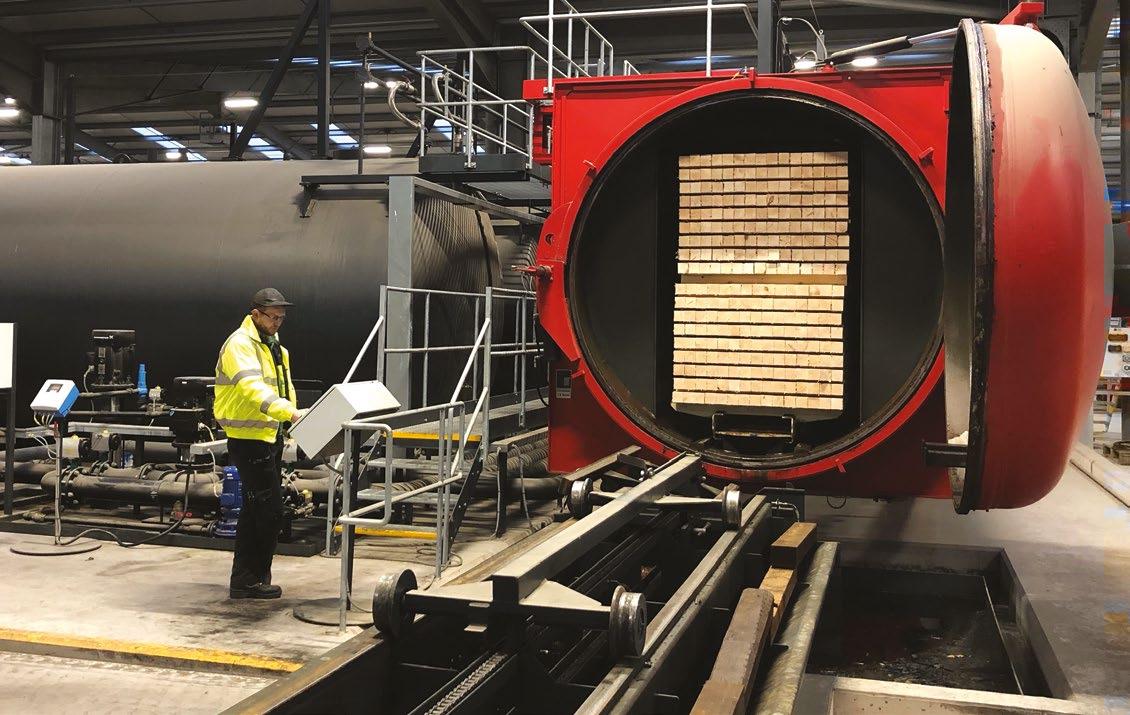
We’re delighted to confirm that we are helping to support and preserve the Wood Protection Association’s campaign to promote the accurate description of preservative treated wood.
Market feedback suggests that meaningless generic expressions such as ‘green treated’ are still prevalent. The inaccurate description of preservative treated products inevitably increases the chance of failure in service and subsequent customer complaints, particularly for outdoor and landscaping applications.
The Wood Protection Association (WPA) believes the answer is to keep the message as simple as possible and communicate it regularly through the right channels. To that end, we have now confirmed that we will be supporting the WPA to help promote a consistent message across our membership network and the landscaping sector.
It’s a mistake to assume that all pressure treated wood is the same. Whilst one piece of treated wood may look very much like any other, the level of preservative protection could be very different. That’s because the British Standard for wood preservation, BS 8417, requires that the loading and penetration of preservative impregnated into the wood is tailored to the desired end use. Applications for treated wood are therefore grouped into ‘Use Classes’. Specifiers and users of preservative treated wood products must therefore ask for the appropriate Use Class so as to be sure that the products they buy are fit for the intended purpose (See table below).
For those who need further guidance on what the most critical Use Classes mean in practice, WPA have developed new ‘A4 Guidance Notes’ on ‘Understanding Use Class 2,3 & 4’ preservative treated wood. These include a simple explanation of what national standards require for each application, what species are most suitable, what preservative penetration to expect in different treated commodities and the necessary quality control criteria.
For further information or guidance on any of the above please download these new ‘Guidance Notes’ and the ‘WPA Buyers Guide to Treated Wood’ from the resources page of the WPA website via thewpa.org.uk or give them a call on +44(0)1977 558274.

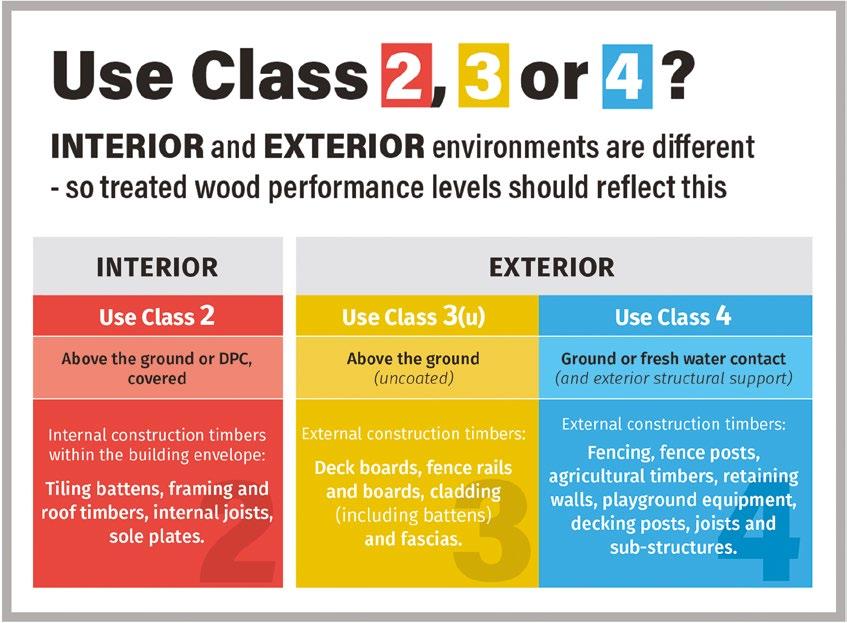

We face a crunch point in our industry. At a time of surging demand for good landscape contractors, our industry is facing a recruitment crisis, with lower numbers of new entrants to replace those retiring exacerbated by Brexit labour shortages.
And yet it feels as if we have not tapped into the most blindingly obvious resource: women. They may make up half of the population, but women account for just 11% of the construction sector workforce and 1% of those on site.
We’ve been talking about better representation for so long that I’m confident we all know the face of the industry must change. The landscape contractors we work with say they are desperate to employ more women and benefit from the skills and
Charlotte Harris doing what she loves best experiences they bring. And of course, diversity extends way beyond gender, too. We all know the hard-nosed metrics - more diverse workplaces result in more profitable businesses.
So what can we do? Organisations like the British Association of Landscape Industries have a golden moment, right now, to champion a new vision. A serious campaign of recruitment aimed at groups not traditionally represented in landscape construction gives us the greatest opportunity to inject new energies. It also helps educate the wider public that landscape construction is a relevant and respected choice for everyone, regardless of background. It is a career of skill and creativity, of attention to detail and achievement.

Getting that message into schools early - before GSCE choices - demonstrates our industry offers fulfilling and meaningful career paths with a myriad of opportunities for women as well as men. We can all play our part in celebrating the richness of careers and opportunities, from project management and procurement through to the trades. Ours is a sector of huge versatility with an endless range of options to develop interests and specialisms.
‘Women Into Construction’ are a brilliant organisation with fantastic mentoring and support programmes; let’s work alongside them to roll out this success in landscape. And we also need to reach out to career changers - women and men - coming to us later in life. Landscape design is full of them; why shouldn’t construction be?
Let’s have open, truthful discussions about the barriers - real or perceived - to women on site and then really commit to working hard to dismantle them. That includes addressing the assumption that work on site is just about physical strength; a misconception that diminishes the skill and craft of contractors as well as the abilities of women. Improving site facilities is a given. Making patterns of work more flexible and more family friendly is good for everyone, not just women.
By creating places that connect people to nature, our industry has demonstrated we have real impact on mental and physical wellbeing. Now more than ever, people are becoming attuned to the importance of landscape. If there’s a rallying moment for us to make meaningful change to the makeup of our workforce, surely it should be now.
© John O’Conner Grounds Maintenance
Women are the hidden pool of talent the landscape industry is crying out for
Report by Charlotte Harris
Co-director of Harris Bugg Studio
www.harrisbugg.com
Outdoor play should be on the Mental Health agenda


The Association of Play Industries (API) has informed Landscape News that they have written to the Government as part of a campaign organised by the All-Party Parliamentary Group on a Fit and Healthy Childhood (APPGFHC) that comprises academics, service providers, charities and practitioners.
An open meeting was called by the APPGFHC on 8th February in response to the publication of the ‘Mental Health White Paper’* which appears to focus heavily on treatments and cures at the expense of prevention. The 70+ attendees have been urged to respond to the White Paper and submit the legislation they would like to see to the Select Committee on Health and Social Care: Inquiry into ‘Children and young people’s mental health’.
API Chair, Mark Hardy, told Landscape News, “Providing outdoor play opportunities is both a protective and a preventative public health measure and urgent and sustained investment in a national network of community playgrounds is needed to safeguard children’s mental health. “The Government must ask why children’s mental health is in crisis and implement policies to prevent so many children reaching breaking point. Outdoor play is essential to children’s normal development and a key factor in their mental health and emotional wellbeing and yet the numbers of public, free-toaccess play spaces are in steep decline. The repeated lockdowns of the last year have meant that children have been under varying degrees of house arrest for months, exacerbating an already worrying trend from outdoor to indoor time. “The relatively modest investment required to create a sustainable network of public playgrounds across the UK would have a substantial, positive effect on the mental health of children and represent a simple yet highly effective public health measure”. To find out more information on the API visit api-play.org.

BALI joins GRO in celebrating World Green Roof Day
Last year we celebrated the inaugural World Green Roof Day. Despite the challenges of a global pandemic, there was plenty of noise around green roofing across social media. Projects from over 57 countries were shared with the Green Roof Organisation (GRO and admired around the globe. This campaign has shown the strength and passion of our landscape community, as well as the skill and talent across the industry.
Chris Bridgman from Accredited Contractor Bridgman & Bridgman LLP told Landscape News, “World Green Roof Day” is now an officially recognised celebratory day of the year, taking place annually on the 6th June. We would love to get as many landscape professionals involved again this year. Green space appreciation and awareness of the climate crisis is one of the better things to emerge from the pandemic. We want to build on this and celebrate green roofs as one way we can address some of the climate and biodiversity issues we face in our lives.”
Members are encouraged to share videos, stories, images and case studies on social media using the hashtag #WGRD2021. You can also find out more about the day at worldgreenroofday. com or for more information on the GRO visit
greenrooforganisation.org











